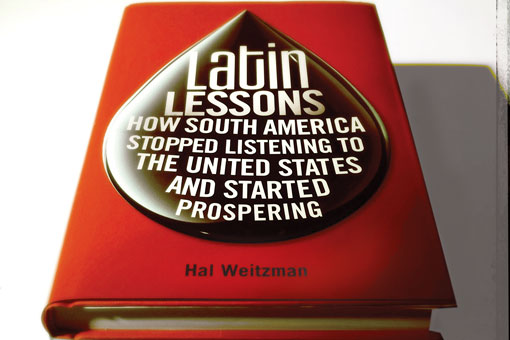South America has been one of the rare pleasant surprises on the global economic scene in recent years. While developed countries struggle with debt and recession, much of the region maintains stability and impressive economic growth. Income is largely on the rise, and unemployment and poverty are on the decline. This is quite a change for a region that used to catch pneumonia whenever the developed countries caught a cold.
In Latin Lessons: How South America Stopped Listening to the United States and Started Prospering, Hal Weitzman, former Andes correspondent for the Financial Times, explores recent political and economic trends—mainly in the Andean countries—to analyze the developments that shaped present-day Bolivia, Ecuador, Venezuela, and, to a lesser extent, Peru. His highly readable book begins with a good review of South America’s long and often sad history as a commodity-producing region.
The author’s central argument is more nuanced than the title suggests. Much of South America is prospering, including the countries that are politically closer to the United States. The region has evolved to the point where it is increasingly shaping its own destiny and pursuing its own blend of economic policies and a foreign policy that is less centered on the United States.
Weitzman provides a concise summary of the momentous changes in Bolivia, Ecuador and Venezuela, where the radical Left came to power and implemented policies very different from the market-oriented economic approach of the Washington Consensus. As he shows, the rise of charismatic leftist leaders, such as Hugo Chávez in Venezuela, Evo Morales in Bolivia and Rafael Correa in Ecuador, was no accident. Their success reflects the failure of previous leaders and previous economic policies to meet public expectations. The ground for radical change (including steps to politically incorporate marginalized communities) was set before these three leaders took power.
The nationalism that led Andean leaders to expel or restrict the role of foreign and private firms in the natural resources sector reflects local experience as well as changing global trends. The persistence of abject poverty in places with a long history of mineral or oil production contributed, rightly or wrongly, to public support for nationalizations. “As the value of their [resource] exports rose dramatically, the people of the region naturally became impatient to experience the benefits,” Weitzman writes.
At the same time, the rise of China—a massive consumer of South American commodities and source of external government funding—has boosted fiscal coffers. This, according to Weitzman, has made it easier for leftist governments to adopt a more hostile posture toward Washington, as well as toward the private sector. The collapse of the U.S. financial system in 2008 and the global recession further undermined the prestige of market-based growth models in the eyes of many Latin Americans.
Weitzman is careful to point out that the radical Left’s success in the Andes is due to more than just charismatic leadership. The governments of Venezuela, Bolivia and Ecuador have reduced poverty and expanded the reach of government services to previously excluded segments of society. This includes delivering health care, food, education, or subsidies to their political bases. However, recent improvements rest on two weak pillars.
First, public institutions remain weak and often corrupt. Hugo Chávez’ policy of using the national energy company, Petróleos de Venezuela, S.A (PDVSA), to fund and deliver social services to the poor reflects the weak state of government institutions. Leaders like Chávez may have expanded the role of the government, but they have not made government institutions more effective or less corrupt. Naturally, this raises doubts about the sustainability of current social policies, Weitzman observes.
Second, the Andean countries are all enjoying a commodity bonanza, thanks to high export prices and to policies that shift a greater share of commodity revenues into the public sector, through either high taxation or nationalization. As Weitzman writes, “The resource nationalism of Chávez, Morales and Correa sought to use oil and gas to pay for the massive redistribution of wealth; but in doing so, they made it likely that the money would run out soon and tied their economies more closely to the notoriously volatile international commodity markets. Their natural resources were their salvation and their likely damnation.”
What is the longevity of the new Andean regimes? Morales, Chávez and Correa have changed the rules of the political and economic game in their countries. Can the Bolivarian revolution in Venezuela survive Chávez? Can Ecuador’s new political and economic order persist after Correa?
Weitzman injects some skepticism by reminding the reader that “Neither nationalization nor shock therapy solved the essential Latin American problems of inequality, poverty, weak political institutions and corruption, so when one failed to work, the pendulum had a habit of swinging back in the opposite direction.”
The new order may be more durable in Bolivia, where the shift in political power to the Indigenous population appears to be structural and permanent.
Beyond economics, Weitzman calls into question the effectiveness of the “war on drugs.” He provides a valuable account of how locals view the policy and its consequences for the region, including on its politics. The rise of Evo Morales, once a leader of Bolivia’s cocaleros, is inextricably bound with Washington’s efforts to eradicate a crop that Indigenous people historicaly grow for customary use.
Latin Lessons outlines the many factors that have led to the growing political distance between the U.S. and Latin America—even as economic and social links have deepened. As Weitzman documents, Latin America accounts for a growing share of U.S. exports (24 percent in 2010, compared with only 14 percent in 1990). The U.S. bought 42 percent of Latin America’s exports in 2010, and the region sells more oil to the U.S. than either Canada or the Middle East. At the same time, more Latin American immigrants live in the U.S. than ever before.
Despite these links, U.S. policy priorities (namely the war on drugs, the isolation of Cuba and free-trade agreements) are increasingly distant from regional priorities, and sometimes in conflict with them. Many in the region agree wih the description of U.S. policy as “a hodgepodge of remnants from previous initiatives that collectively form an incoherent, unsatisfying and unproductive muddle.”
The author advises the U.S. to develop an active presence in Latin America based on an updated understanding of events (rather than on old stereotypes) and a more sophisticated perception of the issues that bind it to the region. He calls for creative thinking, which would include setting a new agenda that avoids the extremes of grand plans and benign neglect. Such an agenda should, in his view, include new approaches to the drug problem and Cuba, as well as immigration, energy security and trade. It should also work to strengthen democracy and public institutions, supporting the rule of law.
Weitzman describes a region that is neither an eternal victim asking for rescue nor a strong, autonomous global player that can ignore American policies and views. He strikes a balance between seeing events in the region as being driven by an all-powerful U.S. and viewing Latin Americans as the full authors of their fate.
Still, his analysis would have been strengthened by enlarging his scope to briefly discuss the moderate Left governments in Brazil and Uruguay. The Brazilian Left rejects the Washington Consensus, but differs from the Andean Left in its views on the role of markets, trade, foreign direct investment, and foreign companies in the economy. The commitment of the Uruguayan Left to work within an institutional framework contrasts sharply with the populist approach of leftist leaders elsewhere.
Similarly, readers would have benefitted from a broader analysis of Peru that goes beyond corruption and social exclusion to include its remarkable economic growth and the corresponding impact on poverty and politics. This would have helped the reader to understand why President Ollanta Humala shifted away from Chávez and identified with former Brazilian President Luiz Inácio Lula da Silva during the 2011 campaign.
Nevertheless, Latin Lessons provides an able synthesis of economic, political and social trends that is not only suitable for general readers and specialists, but can be useful for U.S. policymakers, particularly those working on issues such as drugs, immigration, trade, and energy policy.
Weitzman’s title raises intriguing questions. Did South America really stop listening to the U.S., or was the U.S. message just no longer relevant? While a few Andean countries rejected the economic ideas advocated by the U.S., others settled into a mix of market-oriented policies, openness to trade and foreign investment, along with a more vigorous state role in key economic sectors and in providing social services for the poor.
Perhaps this indicates greater policymaking maturity, reflecting a growing capacity to undertake a more nuanced approach to economic policy. If so, it augurs well for a region that shows more signs of promise.






